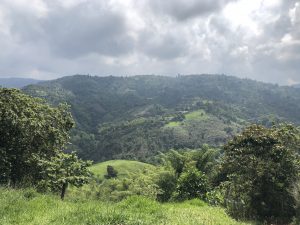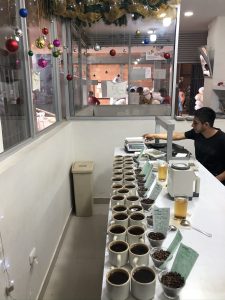If you would like more than 8 samples, please contact a trader directly.
Cart
A trader will contact you with shipping and payment options after checkout. Please note: free samples are provided to commercial roasting businesses only.
It’s not hard to get quality, traceable coffee from Colombia. More difficult is building trust, earning priority, and purchasing intentionally with impact in mind. To add value, we align our purchasing to support partner programs, buy across the quality spectrum, encourage annual innovation, and act as early adopters in bringing new coffee communities to market.
That’s to say that every coffee we get from Colombia is going to be delicious, and as well be in support of some program that’s a priority for our partners. In particular our partners at CENCOIC have proven time again their ability and their determination to use specialty coffee as a vehicle.

While 2019 coffee production crested 13m bags and outpaced many estimates, Colombia is not yet back to pre-royal levels and the national focus remains on increasing production. You can see national policies play in the types of varietals distributed (Colombia, Castillo, Tabi), how they are spaced (tightly; 6k-8k/hectare), how they are washed (.8 – 1 L of water / KG), dried (quickly, and only to 12%), and how they are sold (only Excelso quality washed can be sold as ‘Cafes de Colombia’).
At the cooperative level, however, we find cuppers who know their coffees and talk in terms of score. Calibrating with quality teams allows us to identify communities of interest and dial-in on what good tastes like.
At CENCOIC this team is headed by Lucia, Rodrigo and Henry – all in their young to mid-twenties, and all trained by a joint-program offered by USAID and the Coffee Quality Institute.
Working with them over the past four harvests brought us a more curated selection of offers this year than in season’s past when we took more of a shotgun approach, targeting top profiles with a buckshot of sample requests. Once you know what you are looking for it’s easier to get what you want.

CENCOIC is a collection of 1059 smallholders located around Cauca in Southern Colimbia. Together, this group boasts just over 1000 hectares of coffee under cultivation, but as individuals farms are small and yields are too (1.25 – 1.50 KG cherry / tree).
This area was previously controlled by FARC interests, and has only recently opened back up for business. To-date CENCOIC’s major competition is the decision to grow coffee or other illicit crops.
CENCOIC has been active for many years, but was organized as an exporter in 2018 to represent the Nasa indigenous community to the international market. Crop to Cup was lucky to be their first customers in North America since Green Mountain moved to Switzerland.
There are an estimated 60,000 people who still speak the Nasa Yuwe language, and they are located across Tacueyó, Caldono and Las Mercedes (all departments within Cauca). Their motto is “unity, earth, culture and autonomy”, all of which are expressions of their unique identity and history. Their focus is on preserving cultural traditions, social ties, ancient knowledge and their local environment in the context of a country that is quickly commercializing. They describe their farming as ‘traditional practices enhanced by advanced training’.
Activities include training the field and in the classroom, collection of plastics for recycling into flotation tanks, the construction of bio-factories, and ongoing sensitization on environmental protections. Coffees are processed at home; but farmers have been taught how to treat the ‘honey water’ used during fermentation and return it to their fields as fertilizer.
Here, indigenous communities have self-organized into Rezuardos, self-governing municipalities that came about as a result of relatively recent policy changes recognizing indigenous rights and ancestral lands. Here, we find smallholder groups which are more than just coffee cooperatives, they are socio-political movements, stewards of tradition and providers of essential services such as medicine.
And here we meet Herlinda in Caldano, one of CENCOIC’s 18 groups. While at 1700-2100 masl, this is a cold and windy region of Cauca, producing vast variations in both harvest timing and cup profile. We learned how neighbors lend labor to get through the harvest. How honey water is treated and returned to the field. How plastic bottles are recycled into flotation bins. We learned how coffee pays the bills, but premiums from micro lots are what brings home the tocino.
Which is where we come in. Last year we scratched and sniffed through all 18 of CENCOIC’s districts. We cupped hundreds of offers, calibrated with dozens of cuppers, and zoomed in on three neighboring groups: Tacueyó, Caldono and Las Mercedes.
All three Rezuardos are united under the same indigenous council, and speak the same Nasa Yuwe language. All three have strong programs in and around their collection centers, including new buildings for storage, chiva buses used for collection, heavy engagement in the farms (use of agricultural engineers/participation in training), and at collection (involvement of youth in green grading/space used for transparency and education). Leadership is strong, processes are traceable, and morale is high. They celebrate birthdays together, making coffee the centers of their respective communities. Moreover, all three consistently showed up in the cup.
And lastly, abbreviated together, their name spells CATAME, which means ‘cup me’ in Spanish. After the giggling finished it was decided that this could be CENCOIC’s flagship lot for the US.
This year we zoomed-in to look more closely at these communities, and found sub-regions with profiles defined by effervescence, chewy sugars, tropical spices, dried yellow fruits, and deep rich fudge. We traveled to many of these sub-regions and saw how 200 meters can make a six-week difference in harvest. We tasted how cold wind at 800m can make coffee that tastes twice its height. And we delighted in the cup complexity you can get from sourcing more intentionally across even the smallest of sub-regions.
But the most fun came from asking our partners what places, profiles, people or programs grabbed their passion. Follow the coffee and you’ll get a tree. Follow the passion and who knows what you’ll find.
In every case, we found a handful of compelling programs we could get behind. Our 2020 sample plan targets top-performing regions with separation by:
In summary, we have visited the three communities that make up CATAME, meeting with key staff to discuss our goals. Our goal was to review the process for identifying and rewarding premiums, so as to improve our ability to separate lots. Their goal was to learn how we can grow together, and then tie our purchasing in to programs they would like to support. The result is a lineup of offers that provide us with more than great coffee, but many ways forward.

TIMING
Based on harvest timing and your inventory cycle, we are recommending 2020 exports in JANUARY, MAY and JUNE. Cauca has two harvests:
> Harvest 70% comes in October-December (Jan-Feb ship)
> Harvest 30% comes in March-May Harvest (May-June shipment).
Right now is a turbulent time in Colombia, particularly in the South where protests, narco-traffickers, and guerrilla groups make travel – and life – difficult to impossible. The issues are not easy. Indigenous Rezuardos have historically viewed intervention by the national police and military as impositions on their sovereignty, but this has left a vacuum into which several post-FARC groups have expanded – most recently, Mexican cartels engaged in the large-scale production of illicit crops in traditional coffee-growing areas.
Following the disappearance of local leaders – over 36 in 2019 (as of August), cracks in the 2016 peace agreement have opened up into fissures, leaving a people thirsty for peace with a future uncertain.
This means travel restricted; some roads are simply closed, others are ill-advised, and no one drives through these areas at night. To get through checkpoints the agricultural engineers at CENCOIC wear bright red vests and pink caps as uniforms that announce their affiliation and reason for being there.
Aside from the quite literal roadblocks put up in the south, farmers must somehow find access to good labor, and the capital to pay them.
The harvest is hard, and help hard to find. On top of their living costs, pickers make $12 – $15 a day for 80-90 KG cherry; with 6,000-8,000 trees per hectare, that’s 100 – 150 workdays per hectare. That means every hectare requires five pickers working half-time over two months at a minimum cost of say .5m pesos to the farmer (~$2k USD). With one hectare boiling down in to anywhere between 6-8 bags of export, you can see that this labor cost can easily hover around $1.00 / lb.
Add to this money needed for fermentation, pulpers, washing and drying, of storing, transporting, and eventually (hopefully) milling and we see how much money goes out before the cherry comes in.
Farmers in the Rezuardo of Caldano in Cauca take a neighborly approach to solving this problem, trading labor within families and communities. Others hire-in hands from afar, often from these same indigenous communities.
Regardless of what comes next, these are a few things we now know about our coffee from CATAME.
CULTURAL CONTEXT. CENCOIC is truly a social and political organization. Getting more granular on how they work as a group, and who they represent, emphasized the potential for impact, informed ways in which we can be a more supportive partner, explained why they are so eager and competent in providing for specialty.
PRE-FINANCING. One result of the visit was an agreement to provide pre-financing necessary to advance payment to famers contributing to the CATAME lot. In the end, this was accomplished by contracting at last year’s levels – despite a marked market increase – and involving RaCafe, a trusted exporter of scale, who can advance payment to the group. This will result in lower export costs to CENCOIC, advance payment, and a higher overall margin. For us we will see a 5c increase in export price (RaCafe’s administrative fee), but also faster exports of more intentional coffees, and a supply-chain with more protections.
RECYCLING. All farmers contributing to CATAME are participating in a CENCOIC program that has recycled 3740 KG of plastics into coffee equipment: fermentation buckets, tarpaulins for solar driers and durable, light, and safe storage pallets.
FERMENTATION. A youth program in place in CENCOIC is called ‘inclusion generacional’. This USAID-funded program trains a volunteer youth corps on how to run experimentation on processing and fermentation. The goal is to involve younger generations in coffee earlier and to have them pressure their parents to invest in change where the results are better. They are active across the CATAME areas.
USAID COFFEE FOR PEACE. All farmers contributing to CATAME are participating in a program the Coffee for Peace Program, which allows (a) use of USAID and Coffee for Peace Logo, (b) access to additional training, and (c) matching funds for additional programs.
CQI MICRO-PROCESSOR PT.2. All farmers contributing to CATAME are participating in part two of the micro-processor certification program and must pass the quality checklist (separate attachment).
To see more about our producing partners and the offers coming out of Colombia, see our offer list here.